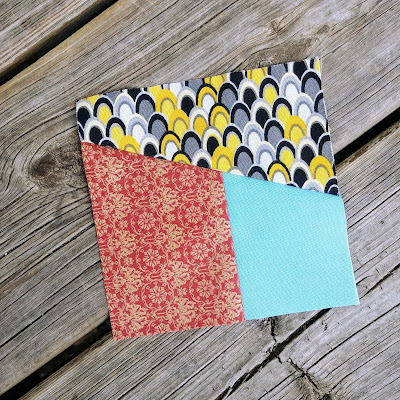
Step 3.
Using your iron, turn under each diagonal edge approx 1/4" and iron the fold. Turn under a second time and iron again.
Sew these edges using a 2 - 2.5mm stitch, keeping your stitches as close the edge of the hem as possible. Reverse the stitches at each end to secure the hem. (photo below)
Step 4.
On each of the 4 sides, turn under 1 1/2" and iron this fold in place. (2 pictures below)
Step 5.
Open the fabric up so you can see the fold line that you just ironed in place.
Step 6.
Turn under the very edge about 1/4" and iron it in place, being careful not to
iron over the 1 1/2" fold line. (photo below)
Step 7.
Fold again on the original 1 1/2" line, press, then sew the hem in place, leaving the open mitered corner for your drawstring. Reverse the stitches at each end to secure the stitching. (photo below)
If the miters don't turn out perfectly even (photo below), this is absolutely fine. You are inserting a drawstring thru the hem and will not see the imperfection.
DRAWSTRING:
Step 1.
Cut 2 WOF (width of fabric) strips 2" wide each. You can use a rotary cutter and ruler or a pair of scissors to cut the fabric.
Step 2.
With right sides together and folded in half lengthwise, sew the raw edges of the long sides of the strip together using a 1/4" seam, reversing at each end to lock in the stitches. You have created an inside-out tube. (photo below)
Step 3.
Attach a safety pin to the edge of the tube at one end.
Step 4.
Stick the safety pin into the opening of the tube.
Step 5.
Feed the safety pin thru the tube to turn it right-side out.
Step 6.
Press it nice and flat, working the seam to the edge as you press. (photo below)
Step 7.
Repeat this process for the second strip, so you will have 2 drawstrings.
Step 8.
With a safety pin attached to one end of each drawstring, insert thru the mitered hems as in the diagram below.
Step 9.
After the drawstrings are each thru 3 sides, tie the ends together with small knots.
Step 10.
Pull at each knot to close your cute little bag.
You did it!
Congratulations on your gorgeous accomplishment!
Thanks for checking in and sewing with me, Melanie
#nocurvesdrawstringbag
Affiliate ads and sponsors allow me to keep this content free.























